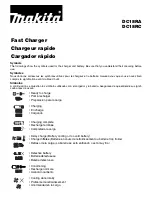
27
26
Lithium manual program
The charger automatically sets the charge current of 1C based on this information.
When you connect the pack to the charger and start the charge process, the charge current
starts at 0.00 A and slowly rises to the set limit.However, please do not be surprised if the
charger does not reach the current you have set, because the charge program constantly
monitors the battery voltage in order to prevent the pack inflating, provided that the voltage of
the individual cells in the pack is the same.When the charger automatically reduces the charge
current, the screen displays the message „
END
“, alternating with the reduced charge current.
The fundamental rule is that Lithium-based batteries may ONLY be charged using
special chargers, and the charge program must be set up correctly in terms of final
charge voltage and capacity for the battery type in use. The charge process is
fundamentally different to that required for Ni-Cd or Ni-MH batteries, and is termed
a constant current / constant voltage method. The charge current required varies
according to the battery capacity, and is set automatically by the charger. Lithium
batteries are usually charged at the 1C rate (1C charge rate = half capacity as charge current. Example:
battery capacity 1500 mAh: 1C charge current = 1500 mA = 1.5 A). For this reason it is essential to set
the charger to the battery capacity instead of the charge current. When the battery on charge reaches
the specific final voltage which is appropriate to the battery type, the charger automatically reduces the
charge current in order to prevent the battery exceeding the final permissible voltage. If the battery
manufacturer states a charge current lower than the 1C rate, then the capacity (charge current) must be
reduced accordingly.
We recommend the use of the Micro Balancer, Order No. 6491, which ensures that your Lithium
batteries are charged optimally, and therefore increases their useful life.
Problems caused by mistreating batteries:
It is very dangerous to overcharge Lithium-Ion batteries, as they tend to react by gassing, overheating
and even exploding. If the final charge voltage of 4.1 V / cell (Lithium-Ion) or 4.2 V / cell (Lithium-Polymer
and Lithium-Manganese) is exceeded by more than 1%, the lithium ions in the cell start to change into
metallic lithium. This material reacts very violently with the water in the electrolyte, and this can result in
the cell exploding. On the other hand it is also important to avoid terminating the charge process before
the final charge voltage is reached, since this reduces the effective capacity of the Lithium-Ion cell
markedly. Stopping the charge at just 0.1 V under the threshold means a capacity loss of around 7%.
Lithium batteries must not be deep-discharged, as this leads to a rapid loss of capacity. This effect is
irreversible; it is absolutely vital to avoid discharging the batteries to below 2.5 V / cell.
Caution: the cell type, cell capacity and cell count set on the charger must always be correct for
the battery to be charged; if you make a mistake, the battery could explode! Never connect a
Lithium-based battery to the charger if it features an integral charge circuit! Always place your
Lithium batteries on a non-flammable surface for charging
This program charges the battery using the capacity
(charge current) which you set.
Before
you initiate the actual program you must set the
capacity of the pack (and thus the maximum charge
current - range 50 … 7000 mAh) using the INC / DEC
buttons.
_ _ _ _ _ _ _ _ _ _ _ _ _ _ _ _
_ _ _ _ _ _ _ _ _ _ _ _ _ _ _ _
L i P o
m a n u a l
C : 2 5 0 0 m A h
DEC
INC
+
-
Lithium discharge program
The purpose of this program is to determine the residual
capacity of a Lithium pack which has not been fully
discharged.
The program discharges the pack using the set discharge
current (0.10 ... 100 A, left of screen) down to the set final
discharge voltage (2.5 ... 37 V per cell, right of screen). It
is not possible to set a final discharge voltage below 2.5 V
per cell, otherwise the battery will suffer permanent
damage.
_ _ _ _ _ _ _ _ _ _ _ _ _ _ _ _
_ _ _ _ _ _ _ _ _ _ _ _ _ _ _ _
L i P o
d i s c h a r g e
1 . 0 0 A
2 . 5 V / c e l l
DEC
INC
+
-
DEC
INC
+
-
ENTER
INC
_ _ _ _ _ _ _ _ _ _ _ _ _ _ _ _
_ _ _ _ _ _ _ _ _ _ _ _ _ _ _ _
DEC
INC
+
-
DEC
INC
+
-
ENTER
DEC DEC
INC
ENTER
Ni-MH discharge program
_ _ _ _ _ _ _ _ _ _ _ _ _ _ _ _
_ _ _ _ _ _ _ _ _ _ _ _ _ _ _ _
N i M H
d i s c h a r g e
1 . 0 0 A
4 . 8 V
DEC
INC
+
-
DEC
INC
+
-
ENTER
13. Lithium programs
Ni-MH-Delta-Peak (-
∆∆∆∆∆
Peak) trigger voltage
It is possible to adjust the trigger voltage (in mV
per
cell!) of
the automatic termination circuit for Ni-MH batteries.
However, Ni-MH batteries have a less pronounced voltage
drop than Ni-Cd cells, and a practical range has proved to
be 5 ... 25 mV / cell. If the trigger voltage is set higher, there
is a danger of overcharging the battery; if set lower, there is
a danger of premature termination.
We recommend that you carry out a series of test charges
to establish the ideal trigger value for your batteries.
Ni-MH conditioning program
These programs are
only
suitable for charging and discharging Lithium-Ion batteries with a
voltage of 3.6 V / cell, and Lithium-Polymer and Lithium-Manganese batteries with a voltage of
3.7 V / cell. The outstanding feature of Lithium batteries is their much higher capacity compared
to other battery types. However, this important advantage is offset by the need to adopt different
handling strategies: they must be charged and discharged using specific methods, otherwise
they will be damaged, and can be dangerous. The directions in these instructions must be
observed at all times when handling these batteries. Specific information and safety notes will
also be found in the battery manufacturer’s technical information.
The typical purpose of this program is to determine the
residual capacity of a transmitter, receiver or drive battery,
or to discharge the pack to a defined level.
In this program the charger discharges the pack using the
set discharge current (0.10 ... 1.00 A, left of screen) until its
voltage falls to the set final discharge voltage (05 ... 16.8 V,
right of screen).
The set final discharge voltage should be a value of around
0.8 ... 1 V
per
cell, in order to avoid the pack becoming
deep-discharged. Deep-discharging a pack runs the risk of
reversing individual cells, i.e. they exhibit reversed polarity.
This program is designed to optimise the capacity of a
battery, and balance the state of its cells.
At top right you can use the INC or DEC button to determine
whether the conditioning program is to start with a charge or
discharge cycle. After this you set the number of cycles
from 1 to 5 (e.g., if you set three cycles, the pack will be
charged and discharged three times). The program dis-
charges the battery using the set discharge current stated
on the right of the screen (0.10 ... 1.00 A), and then rech-
arges it using the charge current (0.1 ... 7.0 A) shown on
the left of the screen. The
charge
process is terminated
automatically in accordance with the values already set for
„Ni-MH Delta Peak cut-off voltage“. The method of reading
out the values for the individual cycles is described in the
section „Screen displays“.
or
_ _ _ _ _ _ _ _ _ _ _ _ _ _ _ _
_ _ _ _ _ _ _ _ _ _ _ _ _ _ _ _
N i M H
d e l t a - p e a k -
v o l t
= 1 0 m V / c e l l
DEC
INC
+
-
charge time
current
voltage
N i M H
c y c l e
C > D
1
C : 2 . 5 A
E : 1 . 0 0 A
















































